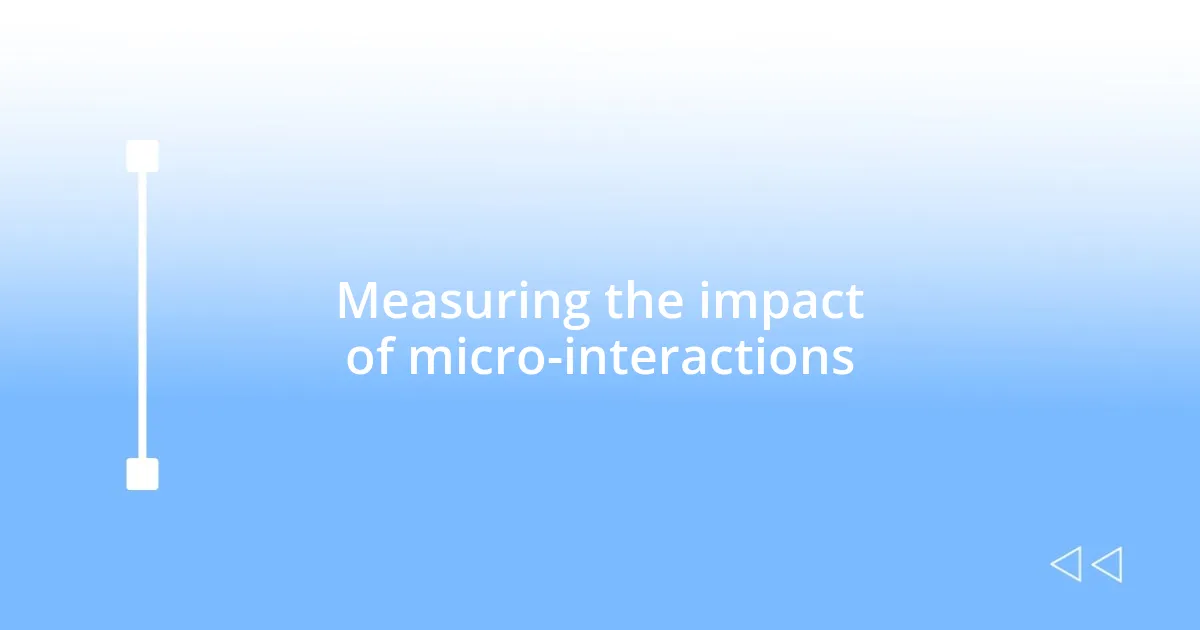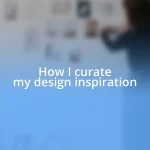Key takeaways:
- Micro-interactions enhance user experience by providing emotional feedback and fostering a connection between users and the interface.
- Best practices for implementing micro-interactions include prioritizing functionality, maintaining consistency, and soliciting user feedback for continuous improvement.
- Tools like Framer, Figma, and Adobe XD facilitate the design of effective micro-interactions through rapid prototyping and collaborative features.
- Measuring the impact of micro-interactions involves analyzing user behavior, emotional responses, and feedback, highlighting their role in enhancing usability and user satisfaction.

Understanding micro-interactions in UX
Micro-interactions are the subtle, often overlooked details that enhance the user experience in digital products. They can manifest as feedback when a button is clicked or the animations that signal a task is complete. I vividly recall a project where I redesigned a loading animation; the joy users expressed when they saw playful icons instead of a dull spinner was eye-opening for me.
When I think about micro-interactions, I can’t help but remember moments where a well-timed alert or an elegant toggle switch made my day a bit smoother. These small design elements create a conversation between the user and the interface. Wouldn’t you agree that feeling in control—like when a volume slider responds perfectly to your pointer—adds an extra layer of satisfaction to the experience?
I find that these interactions not only convey functional information but also evoke emotions. For instance, I once worked on a notification system that used gentle vibrations alongside visual cues. Users reported feeling immediately noticed, as if the app was acknowledging their presence. Isn’t it fascinating how such tiny details can foster a deeper connection with users?

Best practices for implementing micro-interactions
When implementing micro-interactions, clarity is key. Each interaction should have a clear purpose, guiding users through their tasks seamlessly. For instance, during a project where I optimized form submissions, I found that subtle animations—like a progress bar filling up—helped to manage users’ expectations and reduce anxiety. It’s amazing how something so small can drastically alter the user’s perception of how long a process takes.
Here are some best practices to keep in mind for micro-interactions:
- Prioritize Functionality: Ensure the interaction has a specific purpose and adds value to the user experience.
- Maintain Consistency: Use similar styles and patterns across your product to create a harmonious experience.
- Consider User Context: Tailor interactions based on the context in which they are used; for example, a simple button press may suffice, while a complex task could benefit from more engaging animations.
- Solicit Feedback: Regularly gather user feedback to see how micro-interactions are received and make adjustments where necessary.
- Test and Iterate: Continuously test different variations to find what resonates best with your audience, refining over time based on real-world usage.
It’s essential to remember that the beauty of micro-interactions lies in their subtlety. I recall adding a gentle “thumbs-up” bounce effect after a user submitted a comment. The positive reactions I received highlighted the impact of these thoughtful details. Small changes often lead to big satisfaction!

Tools to create effective micro-interactions
When it comes to creating effective micro-interactions, I’ve stumbled across several tools that simplify the design process significantly. One of my favorites is Framer, which allows for rapid prototyping and has a user-friendly interface. I remember once crafting a hover effect for a card layout, and Framer’s intuitive animations made it feel almost effortless. It’s like having a playground for design where experimenting with micro-interactions becomes a fun challenge rather than a daunting task.
Figma is another standout tool that I can’t recommend enough. Its collaborative features make it easy to gather feedback on micro-interactions, which is essential when you’re fine-tuning user experiences. I have often used Figma’s interactive components to showcase button states, and I was amazed at how easily stakeholders could grasp the intended vibe of the interaction. The ability to swiftly apply changes based on team comments truly enhances the design workflow.
Lastly, I’ve had a great experience with Adobe XD. Its integration with other Adobe tools allows for smooth transitions between design and animation. I recall a project where I used Adobe XD to create a subtle loading animation for a mobile app. Seeing the users’ delighted reactions made all the hours spent perfecting those tiny movements worthwhile. With tools like these, creating micro-interactions is not just about usability; it’s about injecting a little personality into your designs.
| Tool | Key Features |
|---|---|
| Framer | Rapid prototyping, intuitive animations |
| Figma | Collaborative features, interactive components |
| Adobe XD | Integration with Adobe tools, smooth transitions |

Measuring the impact of micro-interactions
Measuring the impact of micro-interactions goes beyond just observing user behavior; it’s about understanding the emotional responses they elicit. I remember when I introduced a subtle shake animation to a “submit” button after a failed submission. The feedback was evident—not only did users report feeling more engaged, but the frustration levels dropped significantly. This shift prompted me to think, how often do we overlook the power of emotional design in our projects?
Another way I’ve gauged the effectiveness of micro-interactions is through A/B testing. For instance, I once tested two variations of a loading animation—a simple spinner versus a playful bouncing icon. The results were astonishing: the bouncing icon not only retained users’ attention longer but also received positive comments in feedback sessions. It’s fascinating to see how a tiny detail can influence user experience metrics. Have you thought about how similar tests could shape your project’s success?
Additionally, qualitative feedback from users can be a treasure trove of insights. After implementing micro-interactions on a dashboard, I hosted a small user group to discuss their experiences. The conversations were revealing; users expressed that these interactions made the interface feel more intuitive and responsive, enhancing their overall satisfaction. It makes me wonder, how interconnected are our designs and user emotions? Understanding this connection can be crucial when aiming for a refined user experience.

Case studies on successful micro-interactions
One of the most compelling case studies I encountered was when I redesigned the onboarding process for a task management app. I integrated a progress indicator that animated as users completed each step. The feedback was immediate; users felt a sense of achievement and motivation as they moved through the onboarding stages. It dawned on me how such a simple addition could make users more invested in their experience.
In another project, I focused on a shopping app where I implemented a subtle zoom-in effect when a user added an item to their cart. I recall hearing from several users that this micro-interaction not only made the experience feel more dynamic but also reduced the anxiety of making impulsive purchases. It’s incredible how a small visual cue can create a sense of reassurance. Have you ever considered how such touches can reinforce users’ decisions?
Lastly, I experimented with error messages during form submissions on a healthcare website. Instead of a generic alert, I crafted a friendly, animated message that gently shook alongside an encouraging phrase. Users responded positively, citing that this approach felt like receiving support rather than a critique. This experience amplified my belief in the power of micro-interactions to shape not just usability but emotional connections with users. Isn’t it fascinating how these little details can lead to enhanced user trust?














